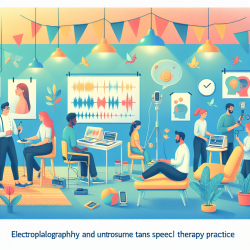As speech-language pathologists, we are always on the lookout for innovative tools and techniques that can enhance our practice and improve outcomes for our clients. A recent study titled "Exploring the Use of Electropalatography and Ultrasound in Speech Habilitation" by Bernhardt et al. (2005) offers promising insights into the use of visual feedback technologies in speech therapy.
Electropalatography (EPG) and ultrasound have emerged as powerful tools for providing real-time visual feedback during speech therapy. EPG shows dynamic tongue-palate contact patterns, while ultrasound displays tongue shapes and movements. These technologies can be particularly beneficial for clients with various speech impairments, including those with hearing impairments, cleft palate, or motor speech disorders.
Key Findings from the Research
- EPG and Ultrasound Effectiveness: The study found that both EPG and ultrasound are effective in improving speech production in clients with diverse etiologies. While EPG is more cost-effective, ultrasound offers broader applications without the need for custom artificial palates.
- Client Improvement: The research highlighted significant improvements in speech intelligibility and articulation accuracy, particularly for adolescents and children. Everyday listeners, who were part of the study, noted considerable gains in the clarity of speech post-treatment.
- Technology Integration: Incorporating these technologies into traditional speech therapy methods can provide a comprehensive approach, enhancing the overall effectiveness of treatment.
How to Implement These Technologies in Your Practice
To integrate EPG and ultrasound into your practice, consider the following steps:
- Training: Obtain specialized training in using EPG and ultrasound for speech therapy. This will ensure you can effectively utilize these tools to provide accurate visual feedback to your clients.
- Equipment: Invest in the necessary equipment. While EPG systems like WIN-EPG are cost-effective, ultrasound machines offer broader applications. Evaluate your budget and client needs to make an informed decision.
- Client Selection: Identify clients who would benefit most from these technologies. The research suggests that children and adolescents, as well as clients with specific speech impairments, show significant improvements with visual feedback.
- Combining Methods: Use EPG and ultrasound alongside traditional speech therapy techniques. This combined approach can provide a more comprehensive treatment plan, addressing various aspects of speech production.
Encouraging Further Research
While the current research offers promising results, it also highlights the need for further studies to determine the long-term effectiveness and broader applications of EPG and ultrasound in speech therapy. As practitioners, we can contribute to this body of knowledge by documenting our experiences and outcomes when using these technologies.
By embracing innovative tools like EPG and ultrasound, we can unlock the speech potential of our clients, helping them achieve clearer and more effective communication.
To read the original research paper, please follow this link: Exploring the Use of Electropalatography and Ultrasound in Speech Habilitation.










